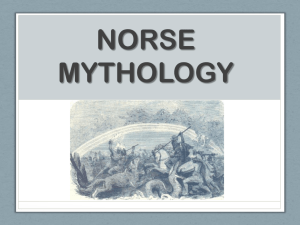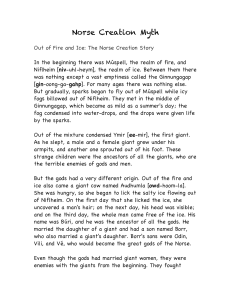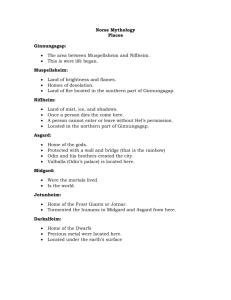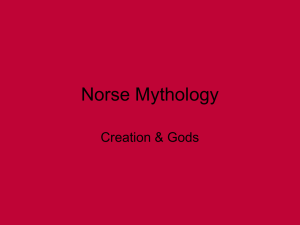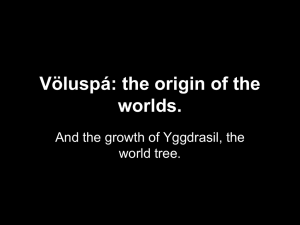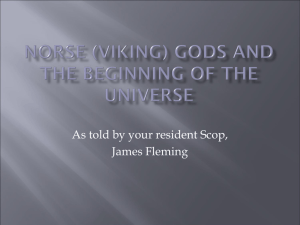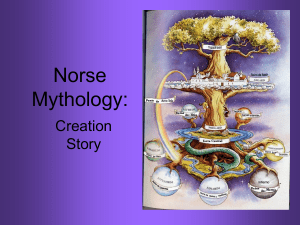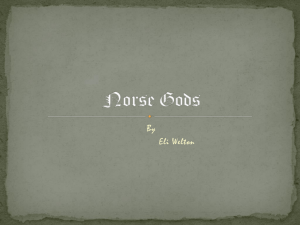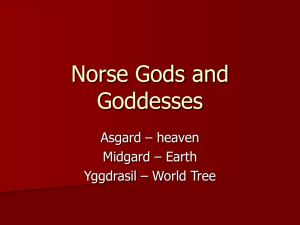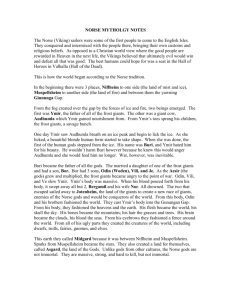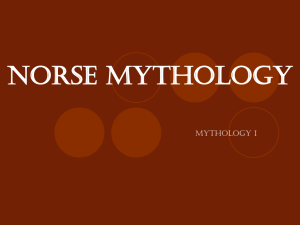Early German Mythology
advertisement
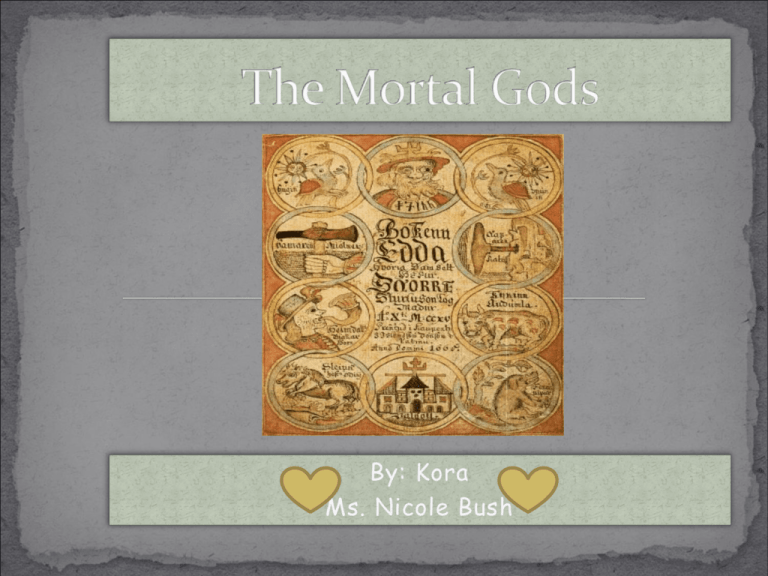
By: Kora Ms. Nicole Bush Anglo-saxons, Scandinavians, Iceland, and Denmark Defined by Tacitus, a Roman, by the language spoken Not Celtic-, Latin-,or Slav-based Each tribe had it’s own name, king and history. Considered barbarians by the Romans. Around 800 ad, different German dialects develop into: • Dutch • English • Flemish • Danish • Swedish • Norwegian • Icelandic • as the different tribes migrate around Europe. 24 letters in the original runic alphabet. Called “futhark” From the order of the first 6 letters Used for recording names on weapons Associated with magic Early Germans worshiped in natural, sacred places Groves Hilltops Islands Heroic Poetry From the oral traditions Two types of poetry Poetic Edda A collection of lays found in 1 Icelandic manuscript Composed around 800 ad. Primary source for: Thor versus Giants Odin as god of wisdom, poetry and magic The death of Balder The creation and destruction of the world Epic Only 1 complete example survives. English Beowulf Germany A fragment of The Tale of Hildibrand and Hadubrand None from Scandinavia survive. 3 areas Niflheim: land of ice, mist and darkness North Muspelsheim: Land of fire South Abyss in between the two Ginnungagap Rivers flow from Muspelsheim Winds from Niflheim Ymir – the first giant Father of giants, humans and gods The Cow – Audhumla 4 rivers flow from her udders Buri born from the drops off her tongue Giant Buri capable of reproducing and bore a son Bor - Married Bestla, one of Ymir’s descendants. 3 gods born of this marriage. Odin, Vili and Ve The race of giants created from Ymir’s sweat Sons of Bor attacked Ymir and killed him Blood filled Ginnungagap One son and his wife survive. God‘s dragged Ymir’s body It’s pieces created Blood – oceans Flesh – earth Bones – mountains Skull – vault of heaven supported by 4 dwarfs Later named the 4 directions Brain – clouds Sun’s sparks got stuck in the vault of heaven Became stars Gods decided and began the rhythm of the seasons Night came first, then day Common in ancient cultures Humans Created after Asgard was built Two tree trunks molded into human shapes Odin – souls Hoenir – senses Lodur – life and color 3 realms Asgard: home of the gods Midgard: home of human race Niflheim: land of the dead Asgard Connected to Midgard by a bridge, The Bifrost Formed by rainbows Contains many halls Valhalla – hall of the slain heros Valaskjalf – houses Odin’s high seat Hlidskjalf Vanaheim – home of the Vanir Alfheim – home of the Light-Elves Midgard Land surrounded by an ocean Inhabited by a huge serpent Niflheim Only giants and dwarfs can live there Hel’s domain Land of ice and darkness An Ash tree Whole world is in the shadow of its branches Roots go deep into the earth and up into the sky 3 roots 1 in Urd’s well Fountain of youth 1 in Niflheim to the Hvergelmir fountain Gives water to all rivers in the world 1 to the fountain of Mimir Fountain of wisdom Will protect 2 humans during Ragnarok Lif and Lifthrasir 2 races of gods Aesir – Gods of war Vanir – Gods of fertility and earth War with each other Compromise – Njord, Freyr and Freyja to Asgard Father and leader of all the gods Master of magic Runes God of war Patron of warriors Decides the fates of warriors Patron god of poetry Weapon Spear – Gungnir Animal attendants Wolves: Geri and Freki Ravens: Huginn (mind) and Munnin (memory) Sleipnir: 8 legged horse God of thunder Destroyer of giants Son of Odin Weapons Hammer – Mjollnir A very short handle Like a boomerang The thunderbolt Magic belt Makes Thor twice as strong Iron gloves God of the sea Invoked for sailing or fishing Extremely rich Married to Skadi He lived in his hall by the sea, she in her hall in the mountains Father of Freyr and Freyja God of human procreation and male potency God of horses During the migration period Many horse remains are found in Viking graves and at sites in Sweden. A horse cult Freyja’s twin brother Resembles the relationship between the Greek Artemis and Apollo Not much is known about this god Son of Odin God of light Adored by all the gods Good natured Beautiful Peaceful His dreams directly precede Ragnarok Killed by Hod Guided by Loki Reborn after Ragnarok Odin’s wife Chief goddess Comparable to Hera in Greek mythology Men prayed to her to Protect marriages Bless them with children She knew the future Told no-one Goddess of erotic and sensual love Mimics the Greek Aphrodite Can turn into a falcon or a feather Shamanistic powers seeress She is described as Desirable Strong willed Passionate Not a god, but allowed to live in Asgard The trickster Nobody was immune from his practical jokes The gods used his advice to get out of sticky situations The wall of Asgard Becomes truly evil after a fashion of playing pranks Father of monsters Sleipnir Hel Fenrir Nordic gods are mortal Everyone dies during Ragnarok; some to be reborn in a new world Starts with Balder’s dream Death of Balder Gods vs. Giants Odin is the first god to die Eaten by Fenrir Avenged by his son, Vidar Freyr is killed by the fire giant, Surt Thor kills the serpent of Midgard Breathes too much poison and falls Loki kills Heimdall, and then is slain Nature Storms and cataclysms Fires, earthquakes and tidal waves Human race dies except Lif and in Yggdrdasill Lifthrasir sheltered The ocean submerges everything The Ginnungagap opens again on all sides at once a new world rises from the waves Everything is new and pure An Eden-like world Some gods are reborn Balder – Master of this world Hod – Balder’s brother Odin’s sons Vidar Vali Odin’s brothers Vili Ve Thor’s sons Magni and Modi Hoenir Announces the new age
